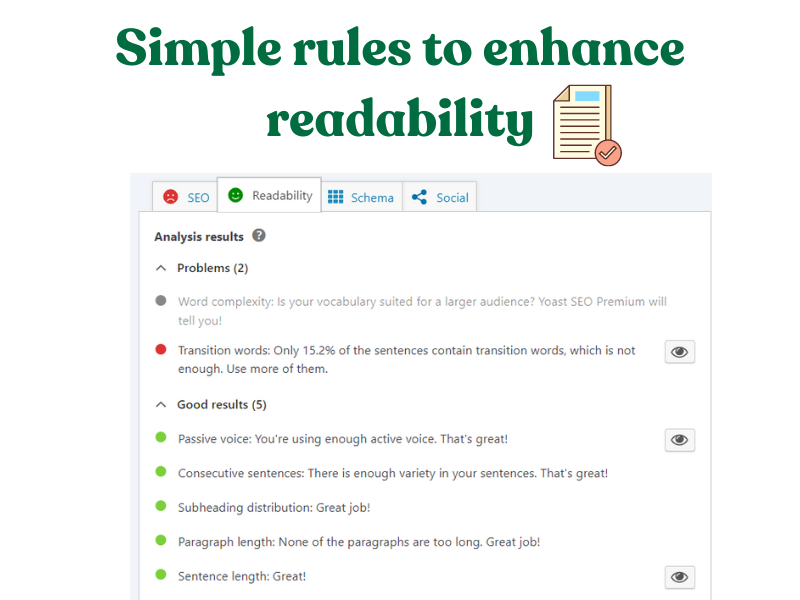Introduction: Why Readability Matters for Your Content
You can write the smartest blog post in the world, but if people can’t read it easily, they won’t stick around. In fact, most will bounce before the second paragraph. Perhaps you’re already thinking about closing this one. I wouldn’t blame you. But hold on a second. The reason some content keeps readers hooked while others get abandoned faster than a group chat about taxes comes down to one thing: readability.
Let’s break down simple rules to enhance readability, with actionable tips that anyone can use to transform their content into engaging, clear, and reader-friendly material.
1. Break It Down with Short Sentences and Paragraphs
Long sentences? Overstuffed paragraphs? These are readability killers. Break up your text into bite-sized chunks to improve flow and make it more digestible. Group related concepts or instructions visually and contextually, reducing cognitive load. For example, present three related steps together with a subtle background shade or border, helping readers process and retain information more efficiently.
- Aim for sentences that are 15-20 words long.
- Stick to paragraphs of 3-4 sentences.
- Keep each idea clear and contained to one paragraph.
Example:
Instead of “We are a company that specializes in multiple fields including SEO, digital marketing, and web development, providing top-notch services to clients worldwide,” try:
“We specialize in SEO, digital marketing, and web development. Our services help clients globally.”

2. Use Bullet Points and Lists to Simplify Complex Information
Whenever you’re explaining a step-by-step process or listing options, use bullet points or numbered lists. Here’s how:
- Break complex instructions into clear steps.
- Highlight important features in a bulleted list.
- Keep each bullet point concise, no more than two lines.
- Lists are scannable.
- They make things look organized.
- Readers love them.
- Google does too.
Structure content so that the most essential information is presented first, with deeper details available through expandable sections or links. This mimics how news sites and technical documentation cater to both skimmers and deep readers.
3. Use Clear, Simple Language: Ditch the Jargon
Subtle animations, hover effects, or tooltips can guide the reader’s attention and clarify meaning without overwhelming the page. For example, highlight key terms that reveal definitions or context on hover, especially useful for multilingual or technical content Your readers aren’t looking for a vocabulary lesson. They want to understand your content quickly without feeling like they’re decoding a secret language. Keep it simple.
- Use everyday language.
- Avoid industry-specific jargon unless necessary.
- When you need to use a complex term, explain it briefly.
4. Choose Readable Fonts and Formatting
Font choice and size matter. Use a clean, easy-to-read font (like Arial, Helvetica, or Georgia) and ensure it’s large enough to be comfortable on all devices. Use font weight, color, and spacing to distinguish between different types of content (quotes, warnings, tips, examples), not just headings. This creates visual landmarks and improves navigation through dense material.
- Font size: 16px for body text is optimal.
- Line spacing: Use 1.5 or 2.0 for better readability.
- Contrast: Use color contrast not just for accessibility but to guide the eye to the most important elements, such as action buttons, key stats, or warnings. Subtle background shading or colored sidebars can help segment content.
- Allow users to adjust font size, line spacing, or even switch between light and dark modes. This user-centric approach is increasingly popular in modern web design for accessibility and comfort
If you are still unsure how to create content will full readaility score, you can outsource a copywriter that can help you.
5. Leverage Headers and Subheaders (H1, H2, H3)
Organizing your content with headers isn’t just for SEO, it’s essential for readability. Break your content into sections with relevant headers and subheaders to guide your reader through the material. Add a one-line summary or callout before complex sections, so readers know what to expect. This primes the brain for the type of information that follows and reduces confusion.
- Start with an H1 for the title.
- Use H2 for major sections.
- H3 and H4 can be used for sub-points under those sections.
6. Add White Space: Give Your Text Room to Breathe
White space (the empty areas between your text and images) improves focus and reduces visual fatigue.
- Leave enough space between paragraphs and sections.
- Use white space to separate important ideas and make your content easier to scan.
- Design your layout for F-shaped or Z-shaped reading patterns, which are backed by eye-tracking studies. Place key information and calls to action along these visual paths.
7. Engage Readers with a Conversational Tone
The days of robotic, corporate-sounding content are over. Readers want to feel like they’re having a conversation with a real person.
- Use “you” and “we” to create a dialogue.
- Avoid passive voice and formal language.
- Share personal experiences and relatable stories to keep things engaging.
Example:
“You’ve probably struggled with writing long paragraphs that lose the reader halfway through. Trust us, we’ve been there too.”
8. Sprinkle in Visuals and Interactive Elements
Adding visuals like images, infographics, and charts can help break up text and reinforce your points. They also improve comprehension.
- Include images to clarify or illustrate complex topics.
- Use infographics to present data in an easy-to-understand format.
- Incorporate videos where appropriate to keep readers engaged.
Incorporate videos where appropriate to keep readers engaged. Consider using resources like A Visual Guide to Keyword Targeting and On-Page SEO.
9. Use Transition Words to Guide Readers
Help your readers follow your train of thought by using transition words. These bridge the gap between sentences and paragraphs, making the content flow naturally.
- Use words like “first,” “next,” and “finally” for lists.
- Try “however,” “on the other hand,” and “as a result” to connect contrasting points.
10. Don’t Forget the Call-to-Action (CTA)
Every piece of content should end with a clear, actionable next step. Whether it’s to read more articles, sign up for a newsletter, or explore a product, the CTA should be bold and obvious.
- Place CTAs at the end of articles and in between sections if relevant.
- For long-form content, include a progress bar or section markers to show readers how far they’ve come. This reduces anxiety about text length and encourages completion.
Don’t just fade out. Tell your readers what to do next. Place CTAs at the end of articles and in between sections if relevant.
- “Want more tips like this? Subscribe to the newsletter.”
- “Need help improving your content? Let’s talk.”
- “Check out our full guide to content strategy.”
- Use action-oriented language like “Discover,” “Learn More,” or “Get Started.”
FAQs
Q: How can I measure the readability of my content?
Use tools like Hemingway App, Grammarly, or the Flesch-Kincaid score. Aim for a grade level of 7-9.
Q: Does readability affect SEO rankings?
A: Yes, readability impacts SEO because content that is easy to read often keeps users on the page longer and reduces bounce rates.
Q: Can visuals really improve readability?
A: Absolutely. Visuals break up large blocks of text and make complex information more digestible, which enhances overall readability.
Conclusion: Readability as the Key to User Engagement
Rules to Enhance Readability isn’t just about making content more pleasant to read, it’s about creating a better user experience, encouraging engagement, and improving your SEO performance. By implementing these simple rules, you’ll ensure your content not only ranks but also speaks to your readers.
Remember, the easier it is for people to read and understand your content, the more likely they are to stay, share, and return for more.
